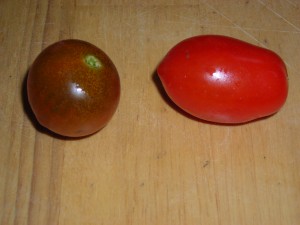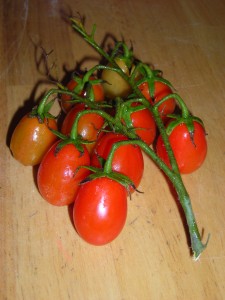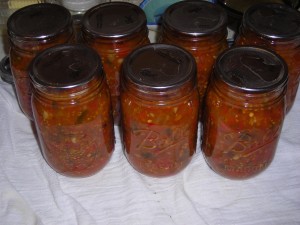I wrote about our patch of tomatoes that overran my pepper plants, and have mentioned

them from time to time since then. Yesterday, I went out and picked all of the ripe fruit from both the volunteer tomatoes, as well as those from the black cherry tomato plants I planted. I was shocked to see how many tomatoes we had ready to pick once I started to pile them together. I had seen all the color developing over the last couple weeks, but putting it all in a single pile really drives home just how many tomatoes I had growing. For free. Voluntarily popping up. Life is GOOD!
I’m not sure what one type is, they are smaller, and Roma- or pear-shaped, but are much smaller than a Roma, about the size of a cherry tomato, only with the odd shape. Interestingly enough, the volunteers,  probably originating from hybrid stock, were not even CLOSE to being as tasty as the heirloom variety of black cherry tomatoes we are growing. And while they are darker than the other tomatoes, I”m not sure why they are called “black, since they seem to be more of a dark green (see photo comparison).
probably originating from hybrid stock, were not even CLOSE to being as tasty as the heirloom variety of black cherry tomatoes we are growing. And while they are darker than the other tomatoes, I”m not sure why they are called “black, since they seem to be more of a dark green (see photo comparison).
The other tomatoes, I’m almost positive are the result of throwing out Compari tomato scraps – these tomatoes have all the traits of Campari tomatoes, same size, same color, and the same clustering of the fruits. You did know a tomato was a fruit, didn’t you? At least it is scientifically speaking.
You see, scientifically speaking, a fruit develops from the ovary in the base of the flower, and contain the seeds of the plant. Apples, blueberries, and papayas are true fruits, and so are many kinds of nuts.
However, culinarily speaking, some scientifically-classed fruits, such as tomatoes or bean pods, may be called ‘vegetables’ because they are used in savoury rather than sweet cooking. The term ‘vegetable’ is more generally used of other edible parts of plants, such as leaves, stalks, and tubers, which are the fruit of the plant from which they come. Occasionally the term ‘fruit’ may be used to refer to a part of a plant which is not a fruit, but which is used in  sweet cooking: rhubarb, for example. Ah, sweet rhubarb….sorry, tangents…
sweet cooking: rhubarb, for example. Ah, sweet rhubarb….sorry, tangents…
So a tomato is a fruit when in science class, but in the kitchen it is a vegetable…. Either way, we had a LOT of them 🙂
Since our pantry was sadly lacking a stockpile of quality salsa, we thought it would be a great time to can some. Hurricane season is here, you know…and as much as I like my Hurricane Salsa, a jar of pre-made from our own garden is always welcome. Preparing now adds variety later! Plus I can always “doctor” it by adding in some dehydrated fruit chips…
On to the canning recipe! Here is Ball’s version, from “Ball Complete Book of Home Preserving”:
| SPICY TOMATO SALSA | |
|
6 pounds tomatoes (about 12 large)
9 dried hot chilies, seeds removed 15 cloves garlic, peeled and minced 3 cups diced red onion 6 jalapeño peppers, seeded and diced 1 1/2 cups chopped cilantro, packed tightly 1 tablespoon salt 3/4 teaspoon dried red chili flakes 3/4 cup red wine vinegar, 5% acidity Prepare Ball® or Kerr® jars and closures according to instructions found in Canning Basics.Peel, seed and dice tomatoes into 1/4-inch size pieces. Place chilies in a small bowl. Pour boiling water over chilies just to cover. Secure plastic wrap over bowl and allow peppers to steep for 15 minutes. Drain half the water from chilies. Purée chilies and remaining water in blender for 1 minute or until smooth. Combine all ingredients in a large saucepot. Bring mixture to a boil. Reduce heat and simmer 10 minutes or until mixture has thickened. Carefully ladle hot salsa into hot jars, leaving 1/4-inch headspace. Remove air bubbles with a Ball® Bubble FREER™ or a nonmetallic spatula. Wipe rim and threads of jar with a clean damp cloth. Place lid on jar with sealing compound next to glass. Screw band down evenly and firmly just until a point of resistance is met – fingertip tight. Process 15 minutes in a boiling-water canner. Yield: about 6 pints. Note: When cutting or seeding hot peppers, wear rubber gloves to prevent hands from being burned. For altitude adjustment increase processing as indicated below: 1,001– 3,000 ft…..5 minutes |
|
I ended up modifying it somewhat, exchanging the vinegar for lime juice, and replacing the  fresh jalapenos with dehydrated ones and adding in some dried, ground up habenero peppers. Having modified the recipe, I made sure to test the pH with my pH meter I have for just this reason. Since we were planning on water bath canning, not pressure canning, the is salsa required to have a pH of 4.6 or lower. Our batch, just before ladling into jars, tested out at 4.3, plenty acidic for safe canning.
fresh jalapenos with dehydrated ones and adding in some dried, ground up habenero peppers. Having modified the recipe, I made sure to test the pH with my pH meter I have for just this reason. Since we were planning on water bath canning, not pressure canning, the is salsa required to have a pH of 4.6 or lower. Our batch, just before ladling into jars, tested out at 4.3, plenty acidic for safe canning.
We had the jars on hand. Lids were $2 for 12. Spices may have cost $0.50, $1.00 for the whole bunch of cilantro, we used about half of it. Limes for the juice were $1.00. Everything else was grown in our back yard. Yield was 8.5 pint jars. Total cost was $3.50. or about $0.41 per jar for home grown, home made salsa.
It’s amazing how much math and science an old Hillbilly has to know just to do some canning!
Forgot to add, it was VERY tasty! And we’ve already eaten almost 1 and a half jars!
Also, please “like” FloridaHillbilly on Facebook, subscribe to my feed, and tell your friends!
And if you live on the Treasure Coast, and you ever want to learn to can something simple, let drop me a line, the wife & I will arrange to show you how it’s done, supervising you through the whole process, you doing the work. If you can read and boil water, you can preserve food. You’ll never taste anything better than what you invested your own sweat into making. Promise.
db

I love me some salsa going to have to try that recipe. I usually just wing it and add whatever spices taste good at the time.
I usually wing it as well, but canning for long-term storage, you REALLY need to pay attention to the particulars, in this case the pH level, and ingredients approved for long-term storage via the water bath method.
db